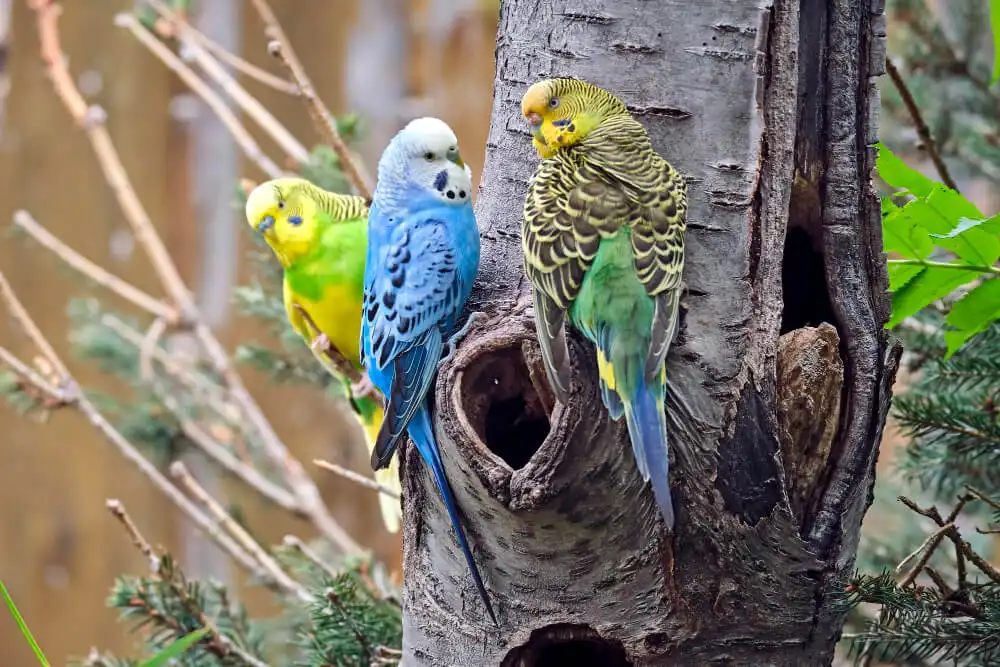Introduction
Welcome to the world of budgerigars, also known as budgies, one of the most popular pet birds around the globe. If you’re curious about budgerigars and want to know more about these fascinating creatures, you’ve come to the right place. This blog post is packed with interesting budgerigar facts, including their history, behavior, and how to care for them.
Budgerigars, with their vibrant colors and charming personalities, make wonderful pets. Whether you’re a seasoned budgie owner or just thinking about getting one, understanding these birds can help you create a happy and healthy environment for your feathered friend. From their diet and nutrition to their unique behaviors and lifespan, we’ll cover all the essential facts you need to know.
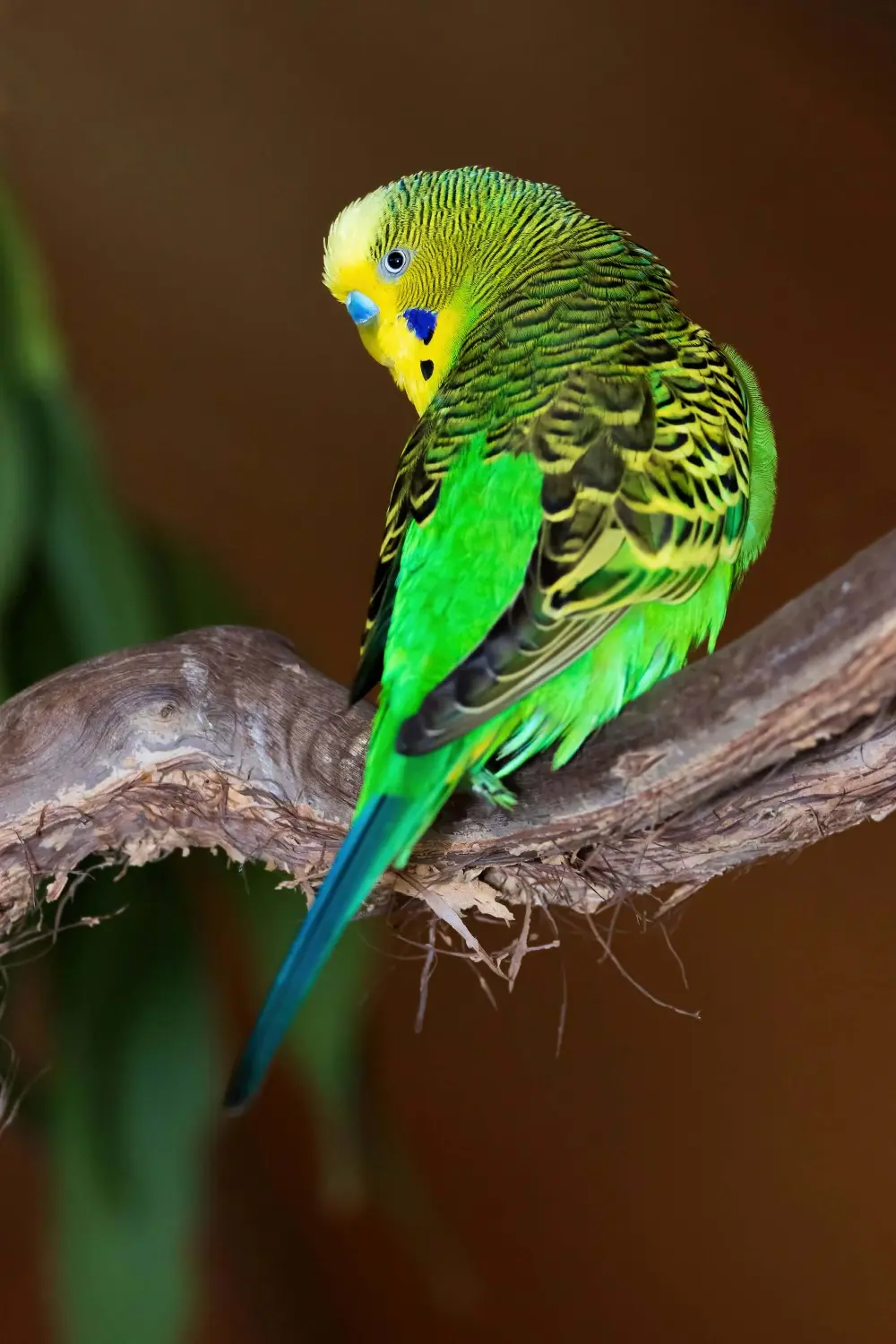
A stunning green and yellow budgerigar shows off its vibrant plumage while perched on a branch.
In this post, you’ll discover fun facts about budgies, tips on training them, and insights into their natural habitat. We aim to provide valuable information in an engaging and easy-to-understand manner. So, let’s dive in and explore the delightful world of budgerigars!
What is a Budgerigar?
A budgerigar, commonly known as a budgie, is a small, colorful parrot native to Australia. These delightful birds are known for their vibrant plumage and playful personalities, making them a favorite among pet owners. Budgerigars are part of the parrot family and are renowned for their ability to mimic sounds and even learn to talk.
Budgies are small, typically around 7 to 8 inches long, with a wingspan of about 12 inches. Their natural coloration is green with black and yellow markings, but selective breeding has produced a wide array of colors and patterns. From bright blues to pure whites, budgies come in a variety of hues that captivate bird enthusiasts.
One of the most interesting facts about budgerigars is their social nature. In the wild, they live in large flocks and communicate with each other through a series of chirps and calls. As pets, budgies thrive on interaction and enjoy spending time with their human companions. They are curious and intelligent, often engaging in playful behaviors that endear them to their owners.
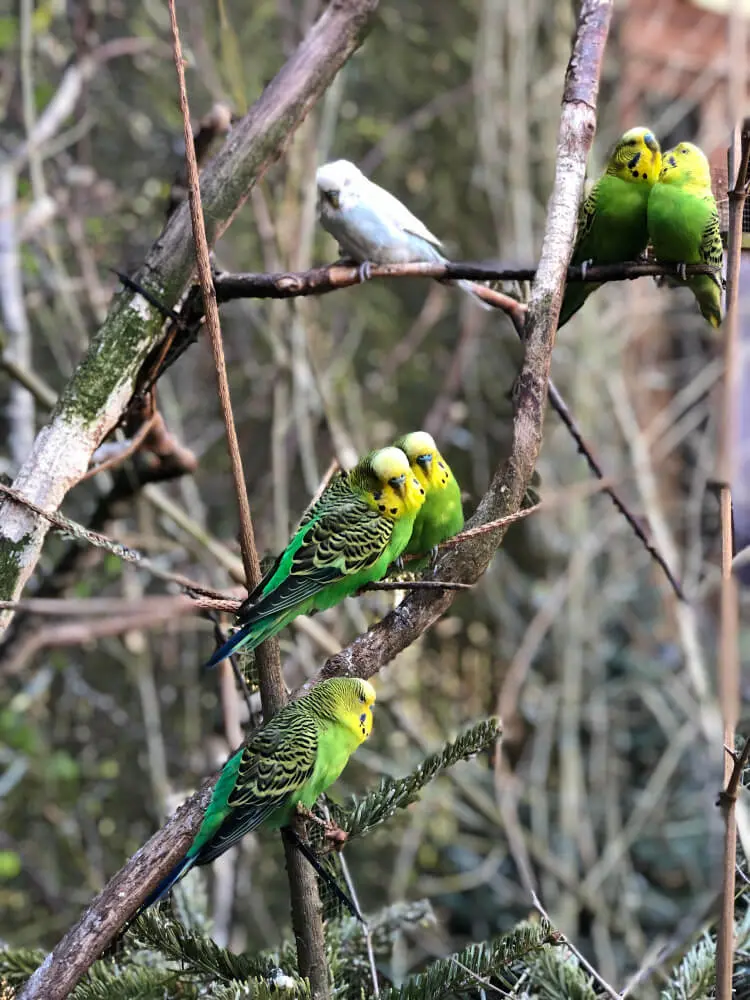
A group of wild budgerigars, showcasing their natural behavior and social structure in their Australian habitat.
Budgerigars are relatively easy to care for, which adds to their popularity as pets. They require a balanced diet, regular exercise, and mental stimulation to stay healthy and happy. With proper care, a budgie can live up to 10-15 years, providing many years of companionship.
In summary, budgerigars are charming, lively birds that make excellent pets for both novice and experienced bird owners. Their striking colors, friendly demeanor, and engaging behavior make them a joy to have at home. If you’re looking to learn more about budgerigar facts, from their diet to their behavior, you’re in for an informative and enjoyable journey.
History and Origin of Budgerigars
The history and origin of budgerigars, or budgies, is as vibrant and fascinating as the birds themselves. These small parrots are native to Australia, where they have roamed the vast landscapes for millions of years. Budgerigars are well-adapted to the Australian environment, thriving in a variety of habitats from open woodlands to grasslands.
Budgerigars were first documented by Europeans in the late 18th century during explorations of the Australian continent. However, it wasn’t until the mid-19th century that budgerigars were introduced to Europe. The first budgerigars arrived in England in 1840, brought back by English ornithologist John Gould. Their striking colors and charming personalities quickly made them popular among bird enthusiasts.
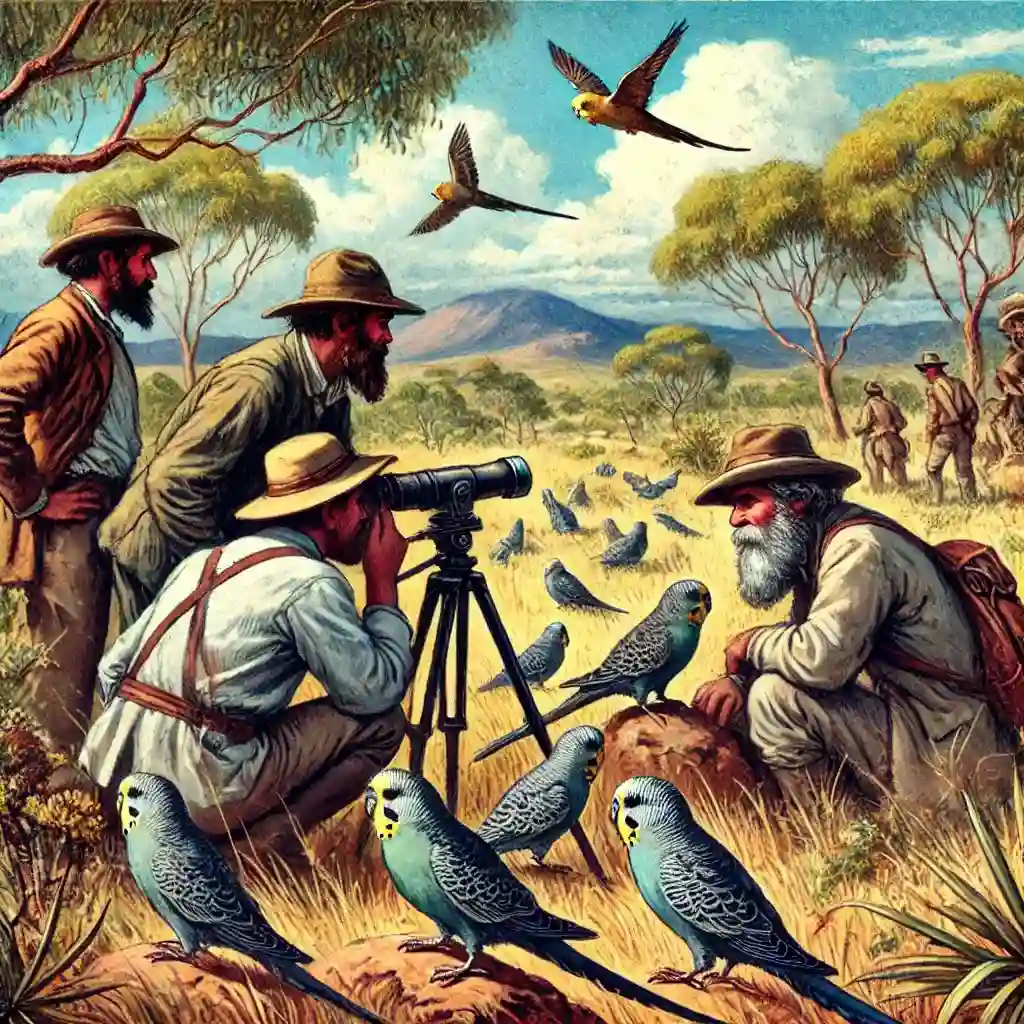
An artistic depiction of early explorers observing wild budgerigars, showcasing the bird’s historical significance.
In their native Australia, budgerigars are known for their nomadic lifestyle, traveling in large flocks in search of food and water. These birds are highly social and rely on their flock for protection and companionship. Their natural diet consists of seeds, fruits, and vegetation found in their arid and semi-arid habitats.
The introduction of budgerigars to Europe and other parts of the world led to extensive breeding programs. Over time, breeders have developed a wide range of color mutations and patterns, making budgies one of the most diverse and visually appealing pet birds available. Despite their global popularity, wild budgerigars remain an iconic symbol of the Australian outback.
One interesting fact about budgerigars is their resilience and adaptability. In the wild, they are known to withstand harsh conditions and can go long periods without water, obtaining moisture from the food they eat. This adaptability has contributed to their success as both wild birds and beloved pets.
Today, budgerigars continue to captivate bird lovers with their beauty and engaging behavior. Understanding their history and origin helps us appreciate these remarkable birds even more. Whether you’re a seasoned bird owner or a curious newcomer, learning about budgerigars’ past enriches our connection to these wonderful creatures.
Physical Characteristics of Budgerigars
Budgerigars, or budgies, are small, colorful parrots that are instantly recognizable thanks to their vibrant plumage and distinctive markings. These physical characteristics make budgerigars one of the most popular pet birds worldwide.
Budgerigars typically measure about 7 to 8 inches in length from the top of their heads to the tips of their tail feathers. They have a wingspan of around 12 inches, making them agile fliers both in the wild and in captivity. Despite their small size, budgies have strong wings that allow them to navigate through the open landscapes of Australia with ease.
The natural coloration of wild budgerigars is predominantly green and yellow with black markings on their wings, back, and head. This coloration provides excellent camouflage in their native habitat. However, through selective breeding, pet budgerigars now come in a dazzling array of colors including blue, white, gray, and various shades of green and yellow. Each color mutation adds to the appeal and diversity of these charming birds.
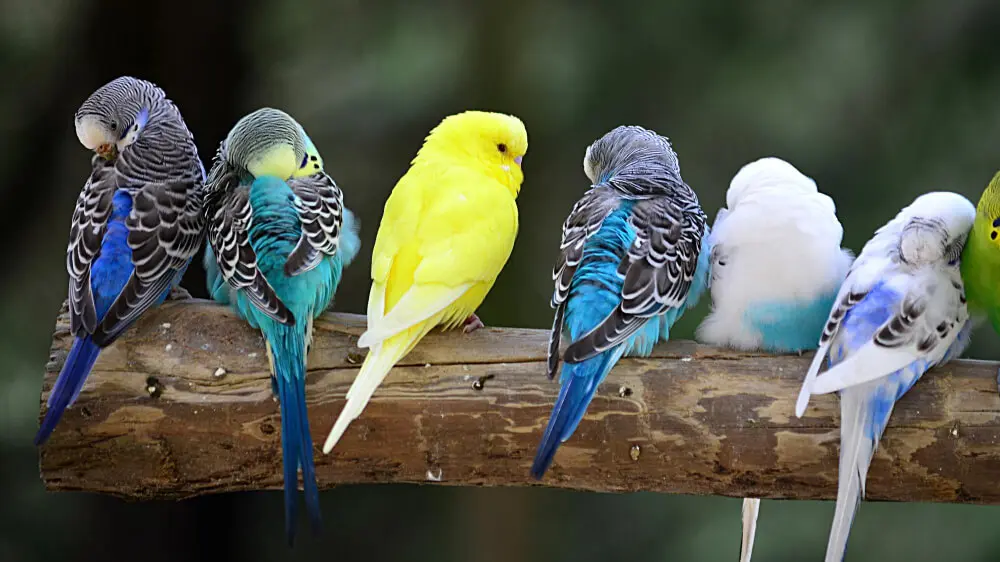
A variety of budgerigar color mutations, displaying the species’ genetic diversity and breeding potential.
One of the most notable physical characteristics of budgerigars is their cere, the area above the beak that houses their nostrils. In males, the cere is usually blue, while in females, it ranges from white to brown, depending on hormonal changes and breeding conditions. This difference in cere color is a key indicator of a budgie’s sex.
Budgerigars also have strong, curved beaks that they use for eating seeds, fruits, and vegetables. Their beaks are not only tools for feeding but also for climbing and playing. Budgies’ feet are zygodactyl, meaning they have two toes facing forward and two facing backward. This toe arrangement helps them grip branches and perches securely.
The eyes of budgerigars are another fascinating feature. They have excellent vision and can see ultraviolet light, which is invisible to humans. This ability helps them find food and recognize mates. The eyes of young budgies are typically dark, while adult budgies have light-colored irises.
In summary, the physical characteristics of budgerigars, from their bright plumage to their distinctive beaks and feet, make them unique and appealing pets. Understanding these traits not only helps in identifying and caring for your budgie but also deepens your appreciation for these delightful birds. Whether you’re drawn to their striking colors or their lively personalities, budgerigars are truly a joy to behold.
Common Colors and Varieties
Budgerigars, or budgies, are renowned for their stunning array of colors and varieties, making them a popular choice for bird enthusiasts. While wild budgerigars are typically green and yellow, selective breeding has introduced a spectrum of beautiful color mutations and patterns in pet budgies.
Green and Yellow Budgerigars
The natural coloration of budgerigars is a vibrant green body with a yellow head, complemented by black markings on their wings and back. This classic look remains a favorite among budgie owners and is often the first image that comes to mind when thinking about these birds.
Blue Budgerigars
Blue budgerigars are one of the most common color mutations. They come in shades ranging from sky blue to cobalt and violet. These birds typically have a white face and blue body, creating a striking contrast that captivates many bird lovers.
Albino and Lutino Budgerigars
Albino budgerigars are entirely white with pink eyes, while lutino budgerigars are completely yellow with red eyes. These varieties are particularly unique due to the absence of the typical budgie markings, making them stand out in any aviary.
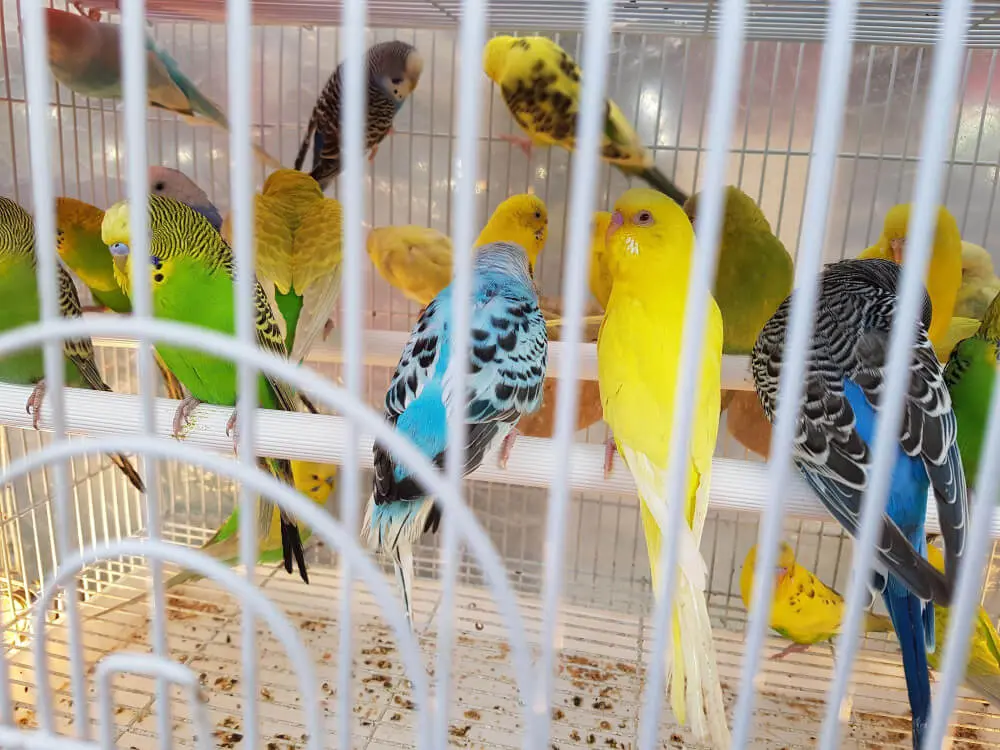
A close-up of budgerigars in a cage, showcasing their diverse and vibrant plumage.
Grey Budgerigars
Grey budgerigars have a soft, smoky appearance, with shades varying from light grey to a deeper charcoal. Their understated elegance makes them a popular choice for those who prefer more muted colors.
Opaline Budgerigars
Opaline budgerigars have a unique pattern where the typical black markings on their wings are replaced by lighter shades, giving them a soft, almost pastel appearance. This variety can come in many colors, including green, blue, and yellow.
Spangle Budgerigars
Spangle budgerigars have an eye-catching pattern where the black markings on their wings are replaced with white or yellow, creating a spangled effect. This variety adds a touch of sparkle and is highly sought after for its distinctive look.
Pied Budgerigars
Pied budgerigars have patches of color interspersed with areas of white or yellow. There are different types of pied patterns, including clearflight, recessive, and dominant pied. These patterns create a whimsical, patchwork appearance that is both fun and charming.
Cinnamon Budgerigars
Cinnamon budgerigars have brownish markings instead of the typical black, giving them a warm, soft look. This mutation can occur in various base colors, adding a unique twist to the standard budgie appearance.
In summary, the common colors and varieties of budgerigars offer a delightful palette for bird enthusiasts. Whether you prefer the classic green and yellow or the exotic allure of an albino or lutino, there is a budgie to suit every taste. Understanding these color mutations and patterns not only enhances your appreciation for these beautiful birds but also helps you choose the perfect budgie to bring into your home.
budgerigar behavior and Temperament
Budgerigars, or budgies, are known for their delightful behavior and friendly temperament, making them a favorite among bird enthusiasts. These small parrots are not only beautiful to look at but also bring joy and companionship with their engaging personalities.
Social and Playful Nature
Budgerigars are highly social birds. In the wild, they live in large flocks, and this social nature carries over to their behavior as pets. They thrive on interaction and enjoy being part of a bustling household. Budgies love to play and can spend hours entertaining themselves with toys, mirrors, and bells. Providing a variety of toys can help keep your budgie mentally stimulated and happy.
Vocal Abilities
One of the most fascinating aspects of budgerigar behavior is their ability to mimic sounds. Budgies can learn to imitate human speech and other noises they hear frequently. While not all budgies will talk, many develop a repertoire of sounds and phrases. This ability makes them entertaining companions and can lead to some delightful conversations with your feathered friend.
Affectionate Companions
Budgerigars are affectionate and enjoy spending time with their human companions. They often form strong bonds with their owners and may show affection by sitting on your shoulder, nibbling gently on your fingers, or preening your hair. Regular interaction and gentle handling can strengthen this bond and make your budgie feel secure and loved.
Active and Curious
Budgies are naturally curious and active. They love exploring their environment and will often investigate anything new in their cage or play area. This curiosity can sometimes get them into mischief, so it’s important to ensure their surroundings are safe and free from hazards. Providing a variety of perches, ladders, and toys can help satisfy their curiosity and keep them engaged.
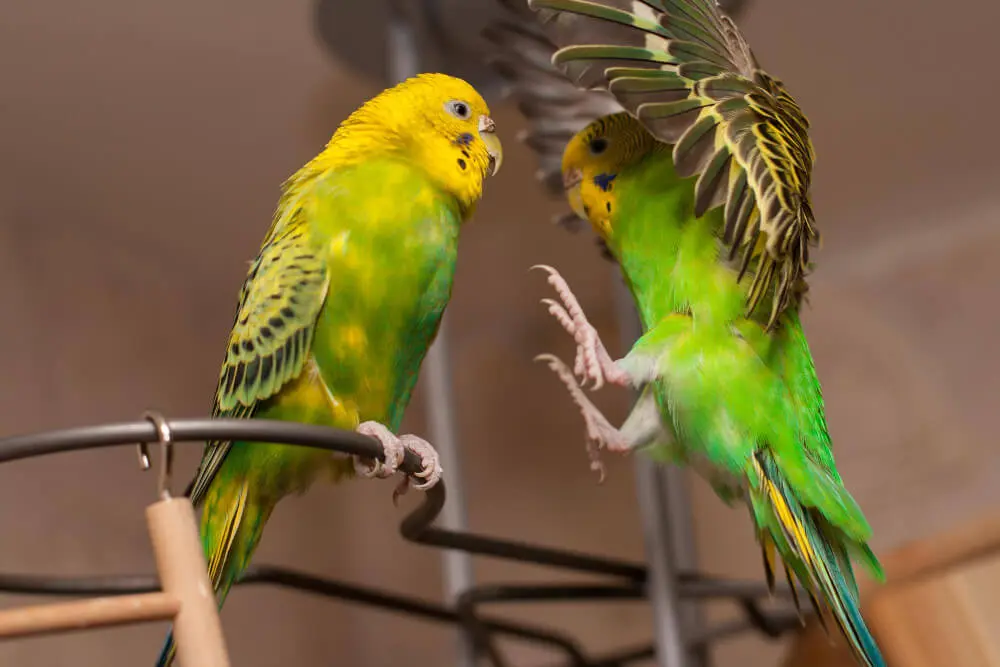
Budgerigars engaging with toys, illustrating the importance of mental stimulation and physical activity for pet birds.
Communication and Body Language
Understanding your budgie’s body language is key to interpreting their behavior. For example, a budgie that is puffing up its feathers might be feeling cold or trying to look bigger to intimidate a perceived threat. A budgie that is bobbing its head or chirping happily is likely in a playful mood. Paying attention to these signals can help you respond appropriately to your budgie’s needs and emotions.
Territorial Behavior
While budgerigars are generally friendly, they can exhibit territorial behavior, especially around their cage or favorite perches. It’s important to respect their space and give them time to adjust to new environments or changes in their routine. Gradual introductions to new toys or cage mates can help reduce stress and prevent territorial disputes.
In summary, budgerigar behavior and temperament are what make these birds such delightful pets. Their social, playful, and affectionate nature, combined with their vocal abilities and curious personalities, ensures that they bring a lot of joy and companionship to any home. Understanding and appreciating these behaviors can help you provide the best care for your budgie and enjoy a fulfilling relationship with your feathered friend.
Budgerigar Diet and Nutrition
A balanced diet and proper nutrition are crucial for keeping your budgerigar healthy and happy. Understanding what to feed your budgie ensures they receive all the essential nutrients they need for a long, vibrant life.
Seed Mixes
Seed mixes form the staple of a budgerigar’s diet, but it’s important to choose high-quality mixes that offer a variety of seeds. Common seeds in these mixes include millet, canary seed, and sunflower seeds. However, seeds alone do not provide a complete diet, as they can be high in fat and lacking in certain vitamins and minerals.
Pellets
Pellets are a great way to ensure your budgie receives a balanced diet. They are formulated to include all the necessary nutrients that budgies need. Pellets should make up a significant portion of your budgerigar’s diet to help prevent nutritional deficiencies. Introduce pellets gradually to your budgie’s diet if they are not accustomed to them.
Fresh Fruits and Vegetables
Incorporating fresh fruits and vegetables into your budgerigar’s diet is essential for their health. Safe options include apples, carrots, broccoli, spinach, and bell peppers. These provide important vitamins and minerals that are not found in seed mixes. Be sure to wash all fruits and vegetables thoroughly and cut them into manageable pieces. Avoid feeding your budgie avocado, chocolate, caffeine, and alcohol, as these can be toxic to birds.
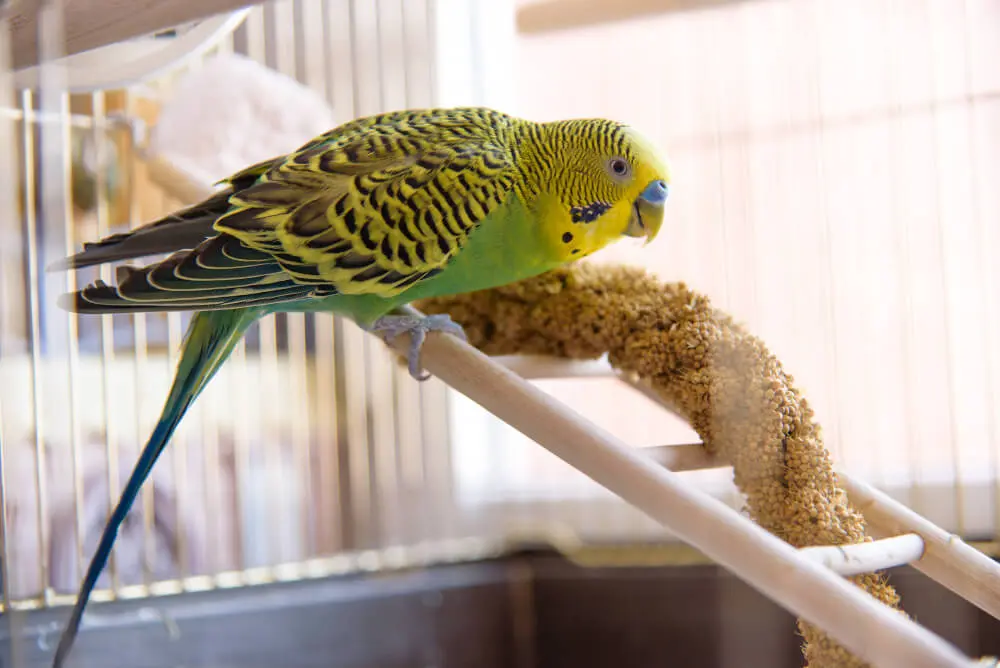
A budgerigar enjoying a healthy diet of seeds and vegetables, emphasizing the importance of a balanced diet for pet birds.
Protein Sources
Budgerigars also need a source of protein. This can be provided through hard-boiled eggs, cooked beans, and small amounts of lean meat. Offering protein-rich foods a few times a week can support your budgie’s growth and feather health.
Calcium and Mineral Supplements
Calcium is vital for budgerigars, especially for females during egg-laying periods. Provide a cuttlebone or mineral block in their cage to ensure they get enough calcium. These supplements also help keep their beaks trim and healthy.
Hydration
Always ensure your budgerigar has access to fresh, clean water. Change the water daily to prevent bacterial growth. You can also offer occasional fruit juices, but ensure they are free of added sugars and preservatives.
Treats in Moderation
While it’s tempting to spoil your budgie with treats, it’s important to do so in moderation. Millet sprays, for example, are a favorite but should be given sparingly due to their high fat content. Treats should not exceed 10% of your budgie’s daily intake to maintain a balanced diet.
Observing Eating Habits
Keep an eye on your budgerigar’s eating habits. Any sudden changes in appetite or preferences can indicate health issues. Regularly check their droppings, as changes can also signal dietary problems or illness.
In summary, a well-rounded diet for a budgerigar includes a mix of seeds, pellets, fresh fruits and vegetables, protein sources, and calcium supplements. Providing this balanced diet will help ensure your budgie remains healthy, active, and full of life. Proper nutrition is the foundation of a happy and long-lived budgerigar, making your feathered friend a delightful companion for years to come.
Health and Lifespan of Budgerigars
Understanding the health and lifespan of budgerigars is crucial for providing them with the best care possible. With proper attention to their health, budgerigars can live happy and fulfilling lives, often exceeding a decade in age.
Average Lifespan
The average lifespan of a budgerigar is between 10 to 15 years. Some budgies have been known to live even longer with excellent care. Factors influencing their lifespan include diet, environment, and genetics. Ensuring a balanced diet and a safe, stimulating environment can significantly extend your budgie’s life.
Common Health Issues
Budgerigars are generally hardy birds, but they can suffer from several common health issues. Recognizing the signs early and seeking veterinary care can make a big difference:
- Respiratory Infections: Symptoms include sneezing, nasal discharge, and difficulty breathing. Proper cage hygiene and avoiding drafts can help prevent these infections.
- Feather Plucking: This can be due to stress, boredom, or underlying health problems. Ensure your budgie has plenty of mental stimulation and a balanced diet to reduce this behavior.
- Psittacosis: Also known as parrot fever, this bacterial infection can cause lethargy, appetite loss, and respiratory issues. It’s treatable with antibiotics but requires prompt veterinary attention.
- Tumors: Older budgerigars are prone to developing tumors, which can be benign or malignant. Regular vet check-ups can help detect and manage these issues early.
- Scaly Face Mites: These parasites cause crusty lesions on the beak, eyes, and legs. Treatment involves specific antiparasitic medication and maintaining good cage hygiene.
Preventive Health Care
Regular veterinary check-ups are essential for keeping your budgerigar in good health. Annual visits can help detect and address health issues before they become serious. Additionally, maintaining a clean living environment is crucial. Clean the cage regularly, provide fresh water daily, and ensure your budgie has a balanced diet.

A veterinarian carefully examining a budgerigar, highlighting the importance of regular health check-ups for pet birds.
Exercise and Mental Stimulation
Budgerigars need regular exercise to stay healthy. Ensure they have enough space to fly within their cage and consider allowing supervised free flight in a safe room. Providing toys, perches, and opportunities for interaction keeps them mentally stimulated and physically active.
Signs of a Healthy Budgerigar
A healthy budgerigar is active, alert, and vocal. Look for bright, clear eyes, clean feathers, and an active interest in their surroundings. Regularly check their droppings; normal droppings are firm with a white part (urates) and a darker part (feces). Changes in droppings can indicate health issues.
End-of-Life Care
As budgerigars age, they may require special care. Older budgies can develop arthritis, making it harder for them to perch. Provide softer perches and ensure easy access to food and water. Monitor their health closely and consult with a vet for advice on managing age-related conditions.
In summary, the health and lifespan of budgerigars depend significantly on the care they receive. Regular veterinary visits, a balanced diet, a clean environment, and plenty of mental and physical stimulation are key to ensuring your budgie lives a long, healthy life. By understanding and addressing their health needs, you can enjoy many happy years with your feathered friend.
How to Care for a Budgerigar
Caring for a budgerigar, or budgie, involves providing a healthy diet, a stimulating environment, and plenty of social interaction. These small parrots are relatively easy to care for, but they do have specific needs to thrive. Here’s a comprehensive guide on how to care for a budgerigar.
Housing
Budgerigars need a spacious cage where they can move around comfortably. The cage should be at least 18x18x18 inches for a single budgie, with horizontal bars for climbing. Ensure the cage has multiple perches of different diameters to promote foot health. Place the cage in a well-lit area away from drafts and direct sunlight, but close to family activity to keep your budgie engaged.
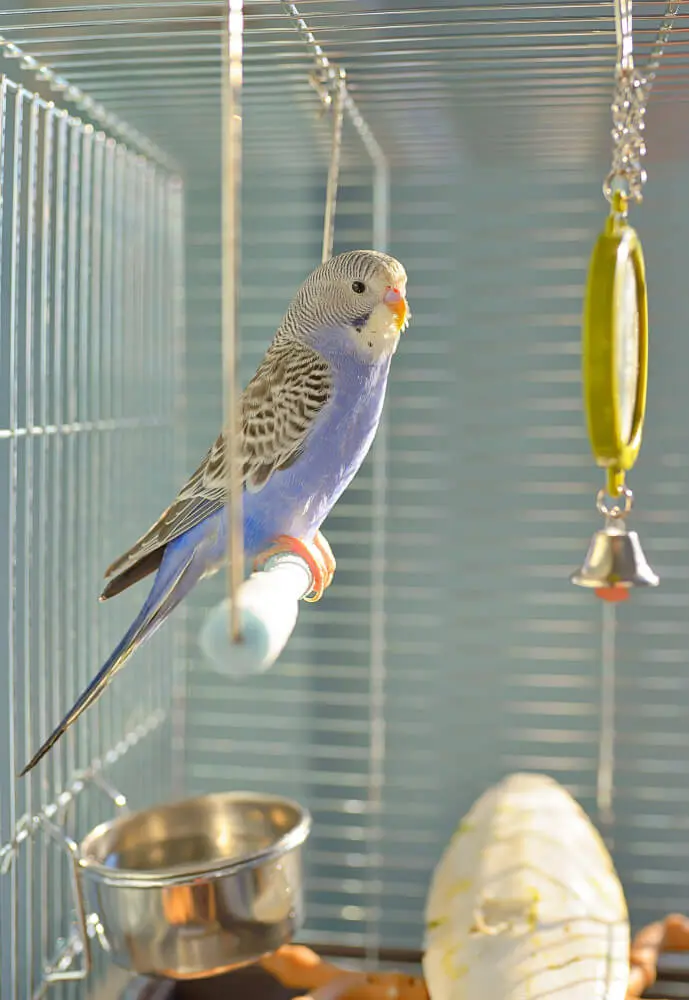
A budgerigar enjoying a well-equipped cage, featuring multiple toys, perches, and feeding accessories.
Diet and Nutrition
A balanced diet is essential for your budgerigar’s health. Provide a mix of high-quality seeds and pellets to ensure they receive all necessary nutrients. Fresh fruits and vegetables should be a regular part of their diet, including options like carrots, spinach, apples, and bell peppers. Avoid feeding them avocado, chocolate, caffeine, or alcohol, as these can be toxic.
Water
Always ensure your budgie has access to fresh, clean water. Change the water daily to prevent bacterial growth. You can also offer occasional fruit juices without added sugars as a treat.
Exercise and Play
Budgerigars are active birds that need regular exercise. Allow your budgie to fly outside the cage in a safe, supervised environment. Inside the cage, provide a variety of toys such as swings, bells, and ladders to keep them entertained and mentally stimulated. Rotate toys regularly to keep your budgie interested.
Social Interaction
Budgerigars are social creatures that thrive on interaction. Spend time talking to your budgie and gently handling them to build trust and bond. If you’re away from home often, consider getting a second budgie for companionship.
Health and Hygiene
Regular veterinary check-ups are important for early detection of health issues. Keep the cage clean by changing the liner daily and washing perches, toys, and food dishes weekly. Monitor your budgie for signs of illness such as changes in appetite, feather condition, or droppings, and seek veterinary care if needed.
Grooming
Budgerigars maintain their feathers by preening, but they also enjoy a good bath. Provide a shallow dish of water for bathing or use a bird-safe spray bottle to mist them lightly. Trim their nails regularly if they don’t wear them down naturally, but be cautious to avoid cutting the quick.
Training
Budgerigars are intelligent birds that can learn tricks and even mimic human speech. Start training sessions in a quiet room free from distractions. Use positive reinforcement with treats and praise to teach your budgie simple commands and tricks. Patience and consistency are key to successful training.
Safety
Ensure your home is safe for a free-flying budgie by removing hazards such as open windows, ceiling fans, and toxic plants. Supervise your budgie during flight time to prevent accidents and keep them out of dangerous areas like the kitchen.
In summary, caring for a budgerigar involves providing a balanced diet, a stimulating environment, and plenty of social interaction. By meeting these needs, you can ensure your budgie remains healthy, happy, and well-adjusted. With proper care, budgerigars make delightful and engaging pets, bringing joy and companionship to any household.
Training and Interaction with Budgerigars
Training and interacting with budgerigars can be a rewarding experience, both for you and your feathered friend. Budgerigars are intelligent and social birds that thrive on mental stimulation and companionship. Here’s how you can effectively train and engage with your budgie.
Building Trust
Before you start training, it’s essential to build trust with your budgerigar. Spend time near the cage, talking softly and offering treats through the bars. Gradually, your budgie will become comfortable with your presence and may start to take treats from your hand.
Basic Training
Start with basic training sessions in a quiet, distraction-free room. Keep sessions short, around 10-15 minutes, to hold your budgie’s attention. Positive reinforcement, using treats and praise, is key to successful training.
- Step-Up Command: Teach your budgie to step onto your finger by gently pressing your finger against its lower chest while saying “step up.” Reward with a treat when it complies.
- Recall Training: Once your budgie masters the step-up command, practice recall training. Gently place your budgie a short distance away and call it to step up onto your finger. Gradually increase the distance as your budgie becomes more confident.

A budgerigar being trained with a millet reward, illustrating effective training techniques for pet birds.
Talking and Mimicking
Budgerigars are known for their ability to mimic sounds and even learn to talk. To teach your budgie to talk:
- Repetition: Repeat words and phrases clearly and consistently. Start with simple words like “hello” or your budgie’s name.
- Positive Reinforcement: Reward attempts at mimicking with treats and praise. Consistency and patience are crucial, as it can take time for your budgie to start talking.
Playtime and Interaction
Budgerigars are playful and enjoy a variety of activities. Providing a range of toys and interacting with your budgie regularly keeps them mentally stimulated and happy.
- Toys: Offer a mix of toys, such as bells, mirrors, and puzzle toys. Rotate them regularly to keep your budgie engaged.
- Interactive Play: Spend time each day playing with your budgie. Simple games like peek-a-boo or teaching your budgie to fetch a small ball can be enjoyable for both of you.
Socialization
Budgerigars are social birds that thrive on interaction. Ensure your budgie feels like part of the family by including them in daily activities. Talk to your budgie, let them perch on your shoulder while you watch TV, or have them nearby while you work.
Behavioral Training
Addressing unwanted behaviors is also part of training. If your budgie exhibits behaviors like biting or excessive screaming:
- Remain Calm: Never punish your budgie physically. Instead, use calm and firm verbal cues.
- Redirect Behavior: If your budgie bites, gently but firmly say “no” and offer a toy to redirect their attention.
- Positive Reinforcement: Always reward positive behavior with treats and praise.
Flight Training
Allowing your budgie to fly in a safe, controlled environment can be beneficial for their physical and mental health. Ensure the room is free of hazards, and supervise closely. Flight training can improve your budgie’s confidence and physical fitness.
Bonding Time
Spending quality time with your budgie strengthens your bond. Simple activities like gentle petting, sharing a snack, or just sitting together can enhance your relationship.
In summary, training and interaction with budgerigars require patience, consistency, and a positive approach. By building trust, providing mental stimulation, and engaging in regular interaction, you can foster a strong, rewarding bond with your budgie. These intelligent, social birds will thrive in an environment where they feel loved and stimulated, bringing joy and companionship into your life.
Fun Facts about Budgerigars
Budgerigars, or budgies, are full of surprises and delightful quirks that make them such beloved pets. Here are some fun facts about budgerigars that highlight their unique characteristics and behaviors.
Talking Talents
Did you know that budgerigars are among the best talkers in the bird world? These small parrots can learn a wide range of words and phrases, often surpassing larger parrots in their vocabulary. The Guinness World Record for the largest vocabulary of any bird is held by a budgie named Puck, who knew over 1,700 words!
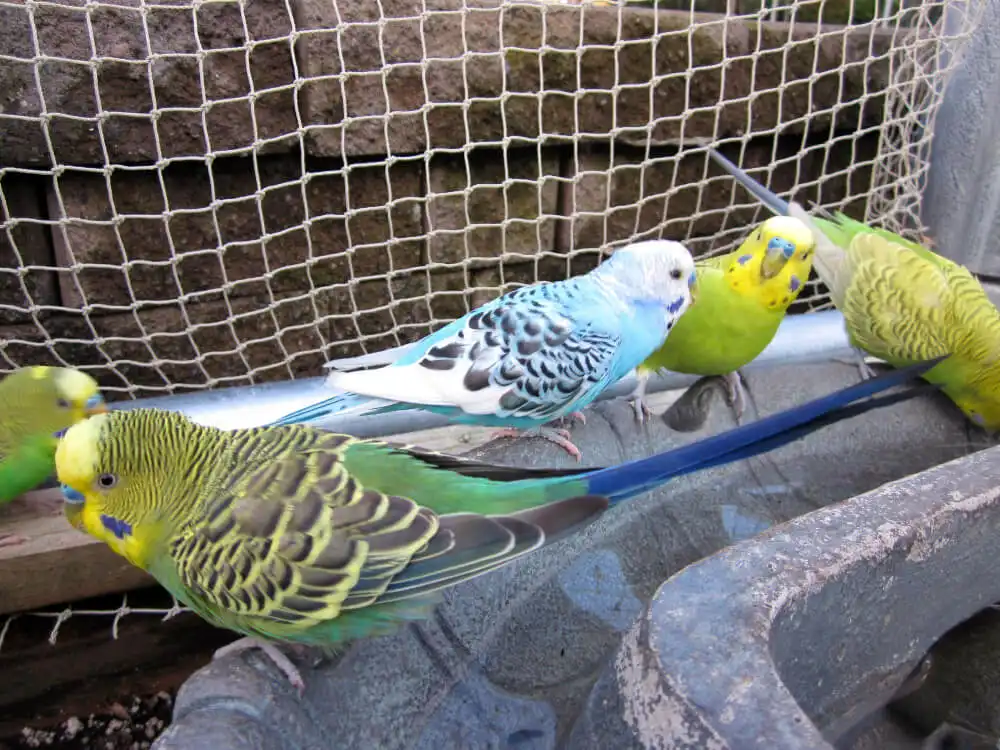
A group of budgerigars interacting and playing, illustrating their social behavior and playful nature.
Color Variations
While wild budgerigars are typically green and yellow, domesticated budgies come in a stunning variety of colors. Through selective breeding, budgies can be blue, white, grey, yellow, and even purple. These color variations make each budgie unique and add to their appeal as pets.
Lifespan Longevity
With proper care, budgerigars can live quite a long time. On average, a healthy budgie can live between 10 to 15 years. Some have even been known to live into their twenties, making them long-term companions.
Native Nomads
In the wild, budgerigars are nomadic birds, traveling great distances across Australia in search of food and water. They live in large flocks and are constantly on the move, which is why they thrive on interaction and activity when kept as pets.
UV Vision
Budgerigars have the remarkable ability to see ultraviolet (UV) light. This ability helps them detect mates and find food, as many seeds and fruits reflect UV light. Their UV vision also enhances the vividness of their feathers, making them even more attractive to potential mates.
Beak Power
A budgerigar’s beak is incredibly strong and versatile. They use it not only for eating but also for climbing, playing, and preening. Despite their small size, their beaks can exert a surprising amount of force, capable of cracking open seeds and even causing a pinch if they feel threatened.
Gender Differences
One way to distinguish male and female budgerigars is by looking at their cere, the fleshy area above their beak. Males typically have a blue cere, while females have a brown or beige cere. This difference becomes more pronounced as they mature, making it easier to identify their gender.
Social Butterflies
Budgerigars are highly social and love being part of a group. In the wild, they communicate with each other through a range of chirps, whistles, and songs. As pets, they thrive on interaction with their human companions and often enjoy the company of other budgies.
Feather Maintenance
Budgerigars are meticulous about their feather maintenance. They spend a good portion of their day preening, which helps keep their feathers clean, aligned, and in good condition. Preening is also a social activity, and budgies will often preen each other as a sign of affection.
Smart and Trainable
Budgerigars are highly intelligent and can be trained to perform a variety of tricks. With patience and positive reinforcement, they can learn to do things like fetch small objects, navigate obstacle courses, and even ride on toy cars. Their intelligence and curiosity make training sessions both fun and rewarding.
In summary, budgerigars are fascinating creatures with many endearing and impressive traits. From their talking abilities to their social nature and striking colors, there’s always something new to learn and appreciate about these delightful birds. Whether you’re a long-time budgie owner or just discovering these wonderful pets, these fun facts about budgerigars highlight why they continue to capture the hearts of bird lovers everywhere.
Conclusion
Budgerigars, with their vibrant colors, playful behavior, and remarkable intelligence, make wonderful pets and delightful companions. Understanding budgerigar facts, from their history and origin to their diet, health, and training needs, is essential for providing the best care for these charming birds.
By offering a balanced diet, a stimulating environment, and regular social interaction, you can ensure your budgie remains healthy and happy. Their ability to mimic sounds and learn tricks, combined with their affectionate nature, makes them a joy to have in any home. Whether you’re captivated by their stunning color variations or their engaging personalities, budgerigars have a unique way of brightening up your life.
Taking the time to learn about their specific needs and behaviors not only helps in creating a better environment for your budgie but also strengthens the bond between you and your feathered friend. Remember, a happy and healthy budgerigar is one that is well-cared for, loved, and engaged.

A yellow budgerigar comfortably perched on its owner’s shoulder, showcasing the bond between pet and owner.
In summary, budgerigars are more than just beautiful birds; they are intelligent, social creatures that can bring immense joy and companionship into your life. By following the guidelines and tips shared in this post, you can ensure your budgerigar thrives and enjoys a long, fulfilling life. So, whether you’re a new budgie owner or a seasoned bird enthusiast, there’s always more to discover and appreciate about these amazing birds.
Frequently Asked Questions about Budgerigars
What is the average lifespan of a budgerigar?
Budgerigars typically live between 10 to 15 years with proper care. Providing a balanced diet, regular veterinary check-ups, and a stimulating environment can help ensure your budgie lives a long and healthy life.
What should I feed my budgerigar?
A balanced diet for a budgerigar includes a mix of high-quality seeds and pellets, fresh fruits and vegetables, and occasional protein sources like hard-boiled eggs or cooked beans. Avoid feeding your budgie avocado, chocolate, caffeine, or alcohol, as these can be toxic.
Can budgerigars talk?
Yes, budgerigars are known for their ability to mimic sounds and learn to talk. With patience and consistent training, many budgies can learn a variety of words and phrases.
How can I tell if my budgerigar is male or female?
You can often determine the gender of a budgerigar by looking at its cere, the fleshy area above the beak. Males usually have a blue cere, while females have a brown or beige cere. This difference becomes more noticeable as the birds mature.
How do I keep my budgerigar entertained?
Budgerigars are active and intelligent birds that need plenty of mental and physical stimulation. Provide a variety of toys, such as bells, swings, and puzzle toys, and rotate them regularly to keep your budgie engaged. Allowing supervised out-of-cage time for flying and exploring also helps keep them entertained.
How often should I clean my budgerigar’s cage?
You should clean your budgerigar’s cage regularly to maintain a healthy environment. Change the cage liner daily, wash food and water dishes daily, and clean perches and toys weekly. A thorough cage cleaning should be done at least once a month.
What are common health issues in budgerigars?
Common health issues in budgerigars include respiratory infections, feather plucking, psittacosis (parrot fever), tumors, and scaly face mites. Regular veterinary check-ups and maintaining good hygiene can help prevent and address these issues.
Can budgerigars live alone, or do they need a companion?
Budgerigars are social birds that thrive on interaction. While they can live alone if they receive plenty of attention from their human companions, they often benefit from the companionship of another budgie. If you are away from home frequently, consider getting a second budgie to keep your pet company.

A budgerigar engaging with its owner, highlighting the importance of interaction and mental stimulation.
How can I train my budgerigar?
Start with basic commands like “step up” by gently pressing your finger against the lower chest of your budgie while saying the command. Use positive reinforcement with treats and praise. Gradually progress to more complex tricks and talking. Keep training sessions short and consistent to maintain your budgie’s attention.
Why does my budgerigar puff up its feathers?
Budgerigars puff up their feathers for various reasons, including staying warm, feeling relaxed, or showing contentment. However, if your budgie is puffed up for extended periods and appears lethargic, it might be a sign of illness, and you should consult a vet.
In summary, understanding the common questions about budgerigars helps provide better care and enhances your relationship with these delightful birds. By addressing their dietary, social, and health needs, you can ensure your budgie remains a happy and thriving member of your family.

